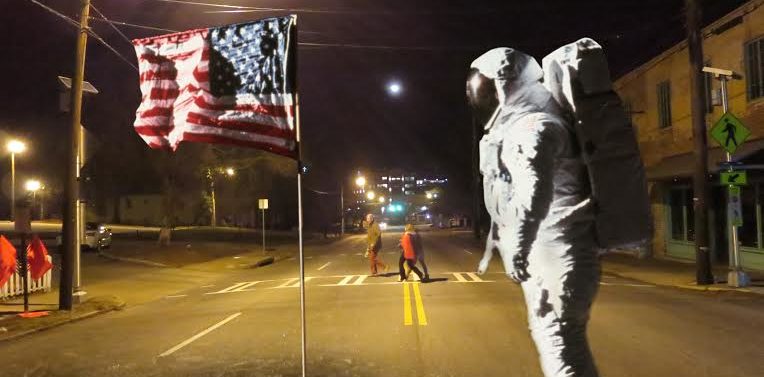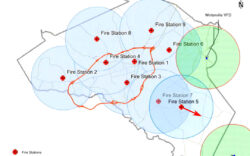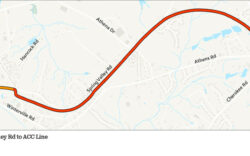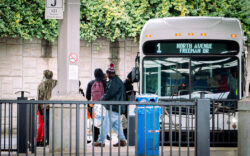Someone at Athens-Clarke County must have heard Flagpole likes flagpoles, because they put a flagpole in front of the Flagpole.
It’s not a joke, although plenty of people confused our initial blog post for an Onion article. There are racks of about a dozen bright orange flags on either side of two notorious Prince Avenue crosswalks, where suburban commuters who’ve been driving 65 on the Loop or Jefferson Highway often don’t slow down or look out for people on foot once they get into the city. Pedestrians are supposed to carry the flags across with them to increase their visibility.
The flags were installed with less than 24 hours’ notice—just enough time for Mayor Nancy Denson to get her picture in the Athens Banner-Herald crossing Prince, probably for the first time ever—and no one asked people in the neighborhood or ran it by the ACC Commission. Some were skeptical; Commissioner Jerry NeSmith called it “the least we can do.” Literally.
Commissioner Kelly Girtz said the flags grew out of a conversation he had with ACC Manager Alan Reddish after state Rep. Regina Quick (R-Athens) refused to support a change in state law to require drivers to stop for pedestrians on the curb, rather than only those who’ve already stepped into the crosswalk. (Yes, it’s a Catch-22.) Quick said that drivers can’t read peoples’ minds. “If you’re holding a flag, no mind-reading is necessary,” Girtz said.
Although Girtz emphasized that the flags don’t preclude more substantive action on Prince—”I think this is just one more piece of the puzzle,” he said—it feels a bit insulting, as if, after thousands of hours of work by citizens and more than a decade of debate, we’re being tossed this bone, and ACC is telling us that pedestrians are entirely responsible for their own safety, not the speeding drivers who blow through the crosswalk like it wasn’t there. Other cities have had mixed success with similar programs, though, so maybe it’s worth a shot. Former Mayor Heidi Davison reports that they’ve been used to great effect in Salt Lake City.
Ironically, mere hours after workers installed the flags, the final draft of the Georgia Department of Transportation safety audit was quietly released. (They have something else in common: Just as Tony Eubanks reported that GDOT engineers and citizens who were walking the corridor last fall were nearly run down, so was an ACC Transportation and Public Works employee who was putting in the flags, according to Andrea Malloy, the manager at the Daily Co-op.)
Instead of listing the hundreds of recommendations tailored to each section of the roadway in the GDOT audit (I’ve linked to the full study on flagpole.com), let me quote from the report’s conclusion, which sums up not only this report but what advocates have been saying since, oh, around 2003. Keep in mind, this is coming from professional engineers who have no stake in our local political wrangling or cultural resentments.
“[O]ne primary safety issue is that drivers do not observe the change in roadway characteristics as they proceed down Prince Avenue into downtown Athens. A gateway is needed to inform the driver that the speeds have decreased and the roadway has changed into an urban environment with significant bicycle and pedestrian volumes. It is recommended as part of this report to provide traffic calming through raised medians, islands and landscaping. This will also give the area a sense of place for the community.
“High speeds and traffic congestion, combined with a lack of pedestrian and bicycle facilities, discourages multi-modal use. Sidewalks should extended across the entire corridor, and existing pedestrian facilities enhanced through improved signage, lighting, warning devices, refuge medians and bulb-outs to encourage pedestrian use. Similarly, inconsistent and unpredictable pavement widths make biking uncomfortable for the many users present on the corridor. Bike lanes should be provided to let cyclists know where they are to be positioned on the roadway, and where motorists can expect them to be.
“Existing mid-block crossing warnings should be evaluated for appropriateness and upgraded accordingly. Pedestrian crossings should be signed consistently throughout the corridor. Pedestrian crossing should also be considered at the Health Science Campus and at Georgia Avenue, areas of heavy pedestrian crossing volume.”
Nowhere in the 38-page document does it mention flags.
Like what you just read? Support Flagpole by making a donation today. Every dollar you give helps fund our ongoing mission to provide Athens with quality, independent journalism.









